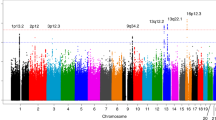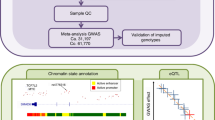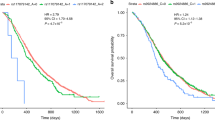Abstract
We conducted a genome-wide association study of gastric cancer and esophageal squamous cell carcinoma (ESCC) in ethnic Chinese subjects in which we genotyped 551,152 SNPs. We report a combined analysis of 2,240 gastric cancer cases, 2,115 ESCC cases and 3,302 controls drawn from five studies. In logistic regression models adjusted for age, sex and study, multiple variants at 10q23 had genome-wide significance for gastric cancer and ESCC independently. A notable signal was rs2274223, a nonsynonymous SNP located in PLCE1, for gastric cancer (P = 8.40 × 10−9; per-allele odds ratio (OR) = 1.31) and ESCC (P = 3.85 × 10−9; OR = 1.34). The association with gastric cancer differed by anatomic subsite. For tumors in the cardia the association was stronger (P = 4.19 × 10−15; OR = 1.57), and for those in the noncardia stomach it was absent (P = 0.44; OR = 1.05). Our findings at 10q23 could provide insight into the high incidence of both cancers in China.
This is a preview of subscription content, access via your institution
Access options
Subscribe to this journal
Receive 12 print issues and online access
$209.00 per year
only $17.42 per issue
Buy this article
- Purchase on Springer Link
- Instant access to full article PDF
Prices may be subject to local taxes which are calculated during checkout

Similar content being viewed by others
References
Parkin, D.M., Bray, F., Ferlay, J. & Pisani, P. Global cancer statistics, 2002. CA Cancer J. Clin. 55, 74–108 (2005).
Engel, L.S. et al. Population attributable risks of esophageal and gastric cancers. J. Natl. Cancer Inst. 95, 1404–1413 (2003).
Tran, G.D. et al. Prospective study of risk factors for esophageal and gastric cancers in the Linxian general population trial cohort in China. Int. J. Cancer 113, 176–181 (2004).
Islami, F. et al. Epidemiologic features of upper gastrointestinal tract cancers in Northeastern Iran. Br. J. Cancer 90, 1402–1406 (2004).
Gao, Y. et al. Family history of cancer and risk for esophageal and gastric cancer in Shanxi, China. BMC Cancer 9, 269 (2009).
Kamangar, F., Chow, W.H., Abnet, C.C. & Dawsey, S.M. Environmental causes of esophageal cancer. Gastroenterol. Clin. North Am. 38, 27–57 (2009).
Ke, L. Mortality and incidence trends from esophagus cancer in selected geographic areas of China circa 1970–90. Int. J. Cancer 102, 271–274 (2002).
Li, J.Y. Epidemiology of esophageal cancer in China. Natl. Cancer Inst. Monogr. 62, 113–120 (1982).
Yang, C.S. Research on esophageal cancer in China: a review. Cancer Res. 40, 2633–2644 (1980).
Zheng, W. et al. Declining incidence is greater for esophageal than gastric cancer in Shanghai, People's Republic of China. Br. J. Cancer 68, 978–982 (1993).
Yu, K. et al. Population substructure and control selection in genome-wide association studies. PLoS ONE 3, e2551 (2008).
Bunney, T.D., Baxendale, R.W. & Katan, M. Regulatory links between PLC enzymes and Ras superfamily GTPases: signalling via PLCɛ. Adv. Enzyme Regul. 49, 54–58 (2009).
Hinkes, B. et al. Positional cloning uncovers mutations in PLCE1 responsible for a nephrotic syndrome variant that may be reversible. Nat. Genet. 38, 1397–1405 (2006).
Bai, Y. et al. Crucial role of phospholipase Cɛ in chemical carcinogen-induced skin tumor development. Cancer Res. 64, 8808–8810 (2004).
Li, M., Edamatsu, H., Kitazawa, R., Kitazawa, S. & Kataoka, T. Phospholipase Cɛ promotes intestinal tumorigenesis of ApcMin/+ mice through augmentation of inflammation and angiogenesis. Carcinogenesis 30, 1424–1432 (2009).
Johmura, Y., Osada, S., Nishizuka, M. & Imagawa, M. FAD24, a regulator of adipogenesis, is required for the regulation of DNA replication in cell proliferation. Biol. Pharm. Bull. 31, 1092–1095 (2008).
Hall, J. et al. The association of sequence variants in DNA repair and cell cycle genes with cancers of the upper aerodigestive tract. Carcinogenesis 28, 665–671 (2007).
Brennan, P. et al. Uncommon CHEK2 mis-sense variant and reduced risk of tobacco-related cancers: case control study. Hum. Mol. Genet. 16, 1794–1801 (2007).
Meijers-Heijboer, H. et al. Low-penetrance susceptibility to breast cancer due to CHEK2(*)1100delC in noncarriers of BRCA1 or BRCA2 mutations. Nat. Genet. 31, 55–59 (2002).
Cybulski, C. et al. CHEK2 is a multiorgan cancer susceptibility gene. Am. J. Hum. Genet. 75, 1131–1135 (2004).
Sakamoto, H. et al. Genetic variation in PSCA is associated with susceptibility to diffuse-type gastric cancer. Nat. Genet. 40, 730–740 (2008).
Lu, Y. et al. Genetic variation of PSCA gene is associated with the risk of both diffuse- and intestinal-gastric cancer in a Chinese population. Int. J. Cancer published online, doi:10.1002/ijc.25228 (3 February 2010).
Yokoyama, A. & Omori, T. Genetic polymorphisms of alcohol and aldehyde dehydrogenases and risk for esophageal and head and neck cancers. Jpn. J. Clin. Oncol. 33, 111–121 (2003).
Cui, R. et al. Functional variants in ADH1B and ALDH2 coupled with alcohol and smoking synergistically enhance esophageal cancer risk. Gastroenterology 137, 1768–1775 (2009).
Park, J.H. et al. Estimation of effect size distribution from genome-wide association studies and implications for future discoveries. Nat. Genet. 42, 570–575 (2010).
Falush, D., Stephens, M. & Pritchard, J.K. Inference of population structure using multilocus genotype data: linked loci and correlated allele frequencies. Genetics 164, 1567–1587 (2003).
Price, A.L. et al. Principal components analysis corrects for stratification in genome-wide association studies. Nat. Genet. 38, 904–909 (2006).
de Bakker, P.I. et al. Practical aspects of imputation-driven meta-analysis of genome-wide association studies. Hum. Mol. Genet. 17, R122–R128 (2008).
Acknowledgements
We thank the study participants and staff of the Shanghai Men's Health Study (SMHS), Shanghai Women's Health Study (SWHS) and Singapore Chinese Health Study (SCHS). Supported by the National Cancer Institute (SMHS: R01 CA82729; SWHS: R37 CA70837 and contract NO2-CP-11010 with Vanderbilt University; SCHS: R01 CA55069, R35 CA53890, R01 CA80205 and R01 CA144034). We thank M.C. Yu and H.-P. Lee for establishing this cohort. Cancer cases were identified through database linkage by the Ministry of Health in Singapore. The Shanxi Upper Gastrointestinal Cancer Genetics Project was supported by the National Cancer Institute contract NO2-SC-66211 with the Shanxi Cancer Hospital and Institute. The Nutrition Intervention Trials (NIT) were supported by National Cancer Institute contracts NO1-SC-91030 and HHSN261200477001C with the Cancer Institute of the Chinese Academy of Medical Sciences. The current analysis was supported by the Intramural Research Program of the NIH, National Cancer Institute, the Division of Cancer Epidemiology and Genetics, and the Center for Cancer Research.
Author information
Authors and Affiliations
Contributions
C.C.A., N.D.F., N.H., Z.W., K.Y., X.-O.S., J-M.Y., W.Z., L.M.D., W.-H.C., A.M.G., S.J.C. and P.R.T. organized and designed the study and served as the study steering committee. M.Y., J.Y., A.H., K.B.J., L.B., M.A.T. and S.J.C. supervised genotyping of samples. C.C.A., N.D.F., Z.W., K.Y., W.W., M.H.G., W.-H.C., A.M.G., S.J.C. and P.R.T. contributed to the design and execution of statistical analysis. C.C.A., Z.W. and S.J.C. wrote the first draft of the manuscript. C.C.A., N.H., X.-O.S., J.-M.Y., W.Z., S.M.D., M.P.L., T.D., Y.-L.Q., Y.-T.G., W.-P.K., Y.-B.X., Z.-Z.T., J.-H.F., C.W., C.A.G., J.F.F., W.-H.C., A.M.G. and P.R.T. conducted the epidemiologic studies and contributed samples to the GWAS and/or second phase. All authors contributed to writing the manuscript.
Corresponding author
Ethics declarations
Competing interests
The authors declare no competing financial interests.
Supplementary information
Supplementary Text and Figures
Supplementary Tables 1–4 and Supplementary Figures 1–5 (PDF 354 kb)
Rights and permissions
About this article
Cite this article
Abnet, C., Freedman, N., Hu, N. et al. A shared susceptibility locus in PLCE1 at 10q23 for gastric adenocarcinoma and esophageal squamous cell carcinoma. Nat Genet 42, 764–767 (2010). https://doi.org/10.1038/ng.649
Received:
Accepted:
Published:
Issue Date:
DOI: https://doi.org/10.1038/ng.649
This article is cited by
-
LINC00240 in the 6p22.1 risk locus promotes gastric cancer progression through USP10-mediated DDX21 stabilization
Journal of Experimental & Clinical Cancer Research (2023)
-
High-density lipoprotein, low-density lipoprotein and triglyceride levels and upper gastrointestinal cancers risk: a trans-ancestry Mendelian randomization study
European Journal of Clinical Nutrition (2022)
-
Evaluation of genetic variants in nucleosome remodeling and deacetylase (NuRD) complex subunits encoding genes and gastric cancer susceptibility
Archives of Toxicology (2022)
-
Accurate prediction of stomach adenocarcinomas of poorest and best prognosis with a combination of gene expression and clinical signatures
Genome Instability & Disease (2022)
-
ABO genotypes and the risk of esophageal and gastric cancers
BMC Cancer (2021)



